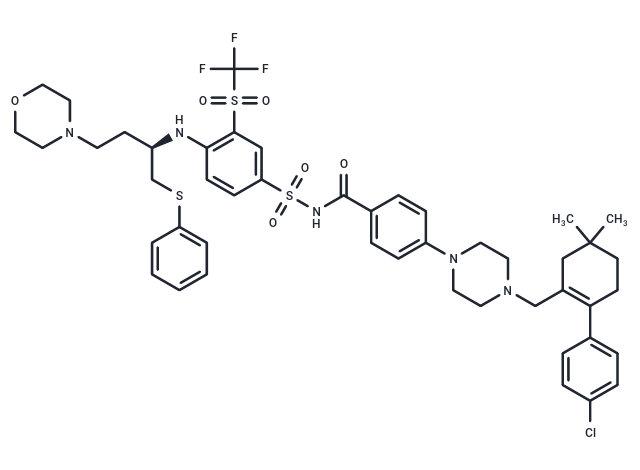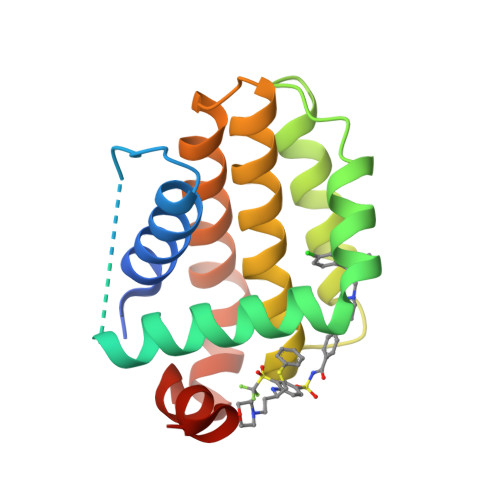 您的购物车当前为空
您的购物车当前为空
Navitoclax
一键复制产品信息别名 ABT-263
Navitoclax (ABT-263) 是一种 Bcl-2 抑制剂,可与 Bcl-xL、Bcl-2、Bcl-w 等蛋白结合 (Ki<1 nM),具有有效性和口服活性。Navitoclax 具有抗肿瘤活性,可以诱导细胞凋亡。

Navitoclax
一键复制产品信息Navitoclax (ABT-263) 是一种 Bcl-2 抑制剂,可与 Bcl-xL、Bcl-2、Bcl-w 等蛋白结合 (Ki<1 nM),具有有效性和口服活性。Navitoclax 具有抗肿瘤活性,可以诱导细胞凋亡。
| 规格 | 价格 | 库存 | 数量 |
|---|---|---|---|
| 1 mg | ¥ 233 | 现货 | |
| 5 mg | ¥ 535 | 现货 | |
| 10 mg | ¥ 797 | 现货 | |
| 25 mg | ¥ 1,370 | 现货 | |
| 50 mg | ¥ 1,980 | 现货 | |
| 100 mg | ¥ 2,890 | 现货 | |
| 200 mg | ¥ 3,960 | 现货 | |
| 500 mg | ¥ 5,820 | 现货 | |
| 1 g | ¥ 7,860 | 现货 | |
| 1 mL x 10 mM (in DMSO) | ¥ 659 | 现货 |
产品介绍
| 产品描述 | Navitoclax (ABT-263) is a Bcl-2 inhibitor that binds to Bcl-xL, Bcl-2, and Bcl-w proteins (Ki<1 nM) with potent and oral activity. Navitoclax has antitumor activity and induces apoptosis. |
| 靶点活性 | BCL-W:< 1 nM (Ki, cell free), BCL-XL:0.4 nM (Ki, cell free), Bcl-2:< 1 nM (Ki, cell free) |
| 体外活性 | 方法:鼠原 B 淋巴细胞 FL5.12/Bcl-xL 和 FL5.12/Bcl-2 用 Navitoclax (0.001-1000 nmol/L) 处理 48 h,使用 CellTiter Glo 方法检测细胞活力。 |
| 体内活性 | 方法:为检测体内抗肿瘤活性,将 Navitoclax (100 mg/kg in 10% ethanol+30% polyethylene glycol 400+60% Phosal 50 PG) 口服给药给携带人 SCLC 和 ALL 异种移植物的 scid 小鼠,每天一次,持续二十一天。 |
| 激酶实验 | ABT-737 and ABT-263 were synthesized as previously described. The enantiomer and BH3-only peptides were synthesized at Abbott. Binding affinities (Ki or IC50) were determined with competitive fluorescence polarization assays. The following peptide probe/protein pairs were used: f-bad (1 nmol/L) and Bcl-xL (6 nmol/L), f-Bax (1 nmol/L) and Bcl-2 (10 nmol/L), f-Bax (1 nmol/L) and Bcl-w (40 nmol/L), f-Noxa (2 nmol/L) and Mcl-1 (40 nmol/L), and f-Bax (1 nmol/L) and Bcl-2-A1 (15 nmol/L). Binding affinities for Bcl-xL were also determined using a time-resolved fluorescence resonance energy transfer assay. Bcl-xL (1 nmol/L, His tagged) was mixed with 200 nmol/L f-Bak, 1 nmol/L Tb-labeled anti-His antibody, and compound at room temperature for 30 min. Fluorescence was measured on an Envision plate reader using a 340/35 nm excitation filter and 520/525 (f-Bak) and 495/510 nm (Tb-labeled anti-His antibody) emission filters. Dissociation constants (Ki) were determined using Wang's equation [1]. |
| 细胞实验 | Human tumor cell lines were maintained at 37°C containing 5% CO2. SCLC cell lines were cultured in RPMI 1640 with 10% fetal bovine serum (FBS), 1% sodium pyruvate, 25 mmol/L HEPES, 4.5 g/L glucose, and 1% penicillin/streptomycin. Leukemia and lymphoma cell lines were cultured in RPMI 1640 supplemented with 10% FBS and 1% penicillin/streptomycin. Cells (1 × 10^4–5 × 10^4) were treated for 48 h in 96-well culture plates in a final volume of 100 μL and cytotoxicity was assessed with the CellTiter Glo assay [1]. |
| 动物实验 | C.B.-17 scid-bg or C.B.-17 scid mice were implanted with 5 × 10^6 (1 × 10^6 for DoHH2) cells in 0.2 mL 50% Matrigel s.c. into the right flank. Tumor-bearing mice were size matched (~235 mm3; day 0) into treatment and control groups, ear tagged, and monitored individually. Tumor volume was measured two to three times weekly by electronic calipers (volume = length × width2 / 2). Tumor growth inhibition was calculated based on the difference in mean tumor volumes between treated and appropriate vehicle control groups. Partial response (PR) is defined as ≥50% tumor growth inhibition, and complete response (CR) is defined as nonpalpable tumor. All studies used 8 to 10 mice per group. ABT-263 was formulated in 10% ethanol, 30% polyethylene glycol 400, and 60% Phosal 50 PG and administered p.o. The other agents used [rituximab, doxorubicin, cyclophosphamide, vincristine, bortezomib, and prednisone] were administered i.p., p.o., or i.v. and formulated according to the manufacturers' recommendations. For combination studies, ABT-263 was given ~2 h before the other agents, except bortezomib, which was given ~4 h before ABT-263 [1]. |
| 别名 | ABT-263 |
| 分子量 | 974.61 |
| 分子式 | C47H55ClF3N5O6S3 |
| CAS No. | 923564-51-6 |
| Smiles | C(C1=C(CCC(C)(C)C1)C2=CC=C(Cl)C=C2)N3CCN(CC3)C4=CC=C(C(NS(=O)(=O)C5=CC(S(C(F)(F)F)(=O)=O)=C(N[C@H](CCN6CCOCC6)CSC7=CC=CC=C7)C=C5)=O)C=C4 |
| 密度 | 1.41 g/cm3 |
| 颜色 | White |
| 物理性状 | Solid |
| 存储 | store at low temperature | Powder: -20°C for 3 years | In solvent: -80°C for 1 year | Shipping with blue ice/Shipping at ambient temperature. | |||||||||||||||||||||||||||||||||||
| 溶解度信息 | Ethanol: < 1 mg/mL (insoluble or slightly soluble) DMSO: 245 mg/mL (251.38 mM), Sonication is recommended. H2O: < 1 mg/mL (insoluble or slightly soluble) | |||||||||||||||||||||||||||||||||||
| 体内实验配方 | 10%DMSO+50% PEG300+5% Tween-80+35% Saline: 10 mg/mL (10.26 mM), Sonication is recommended. 10% DMSO+40% PEG300+5% Tween 80+45% Saline: 20 mg/mL (20.52 mM), Suspension. 请按顺序添加溶剂,在添加下一种溶剂之前,尽可能使溶液澄清。如有必要,可通过加热、超声、涡旋处理进行溶解。工作液建议现配现用。以上配方仅供参考,体内配方并不是绝对的,请根据不同情况进行调整。 | |||||||||||||||||||||||||||||||||||
溶液配制表 | ||||||||||||||||||||||||||||||||||||
DMSO
| ||||||||||||||||||||||||||||||||||||
 化合物与蛋白结合的复合物
化合物与蛋白结合的复合物

Bcl_2-Navitoclax (ABT-263) Complex
计算器
体内实验配液计算器
以上为“体内实验配液计算器”的使用方法举例,并不是具体某个化合物的推荐配制方式,请根据您的实验动物和给药方式选择适当的溶解方案。
剂量转换
对于不同动物的给药剂量换算,您也可以参考 更多




 很棒
很棒
 |
|